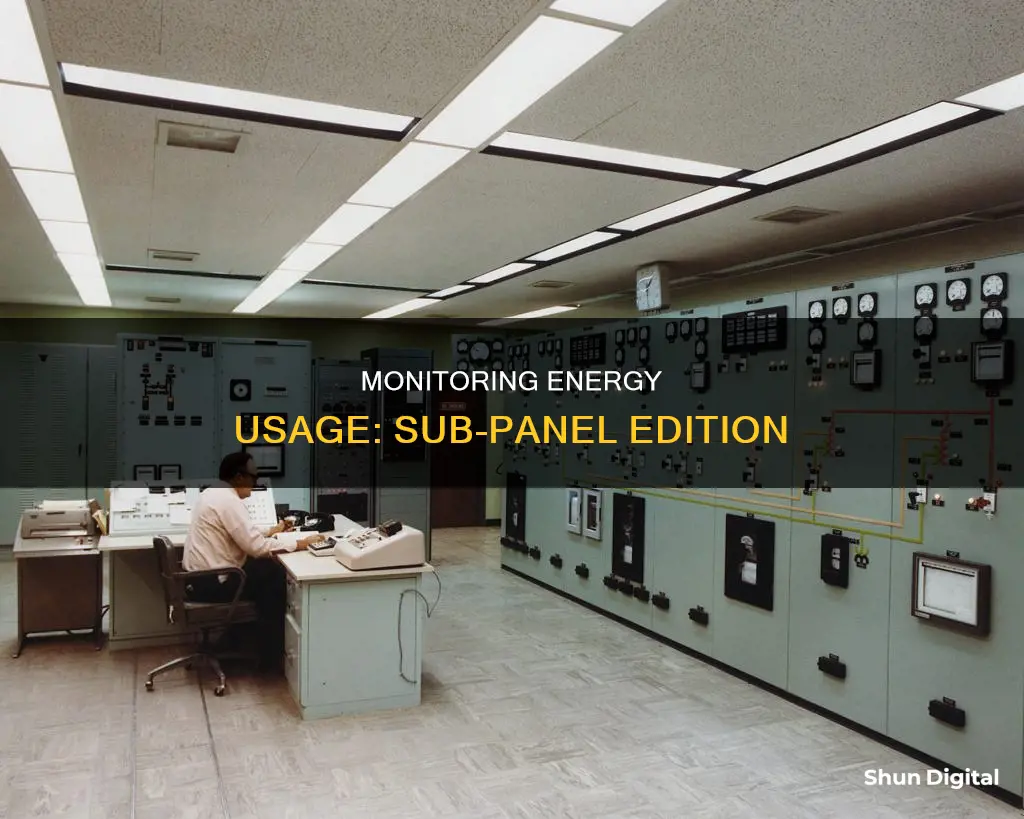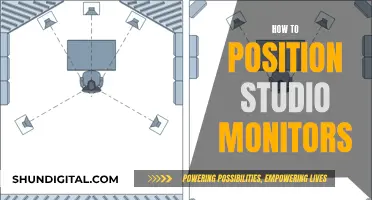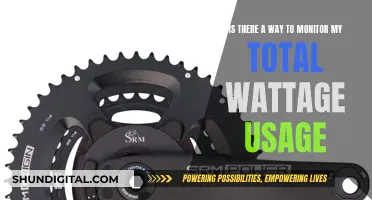
Monitoring energy usage on a sub-panel can be done in two ways. The first is to measure the sub-panel from the main panel, and the second is to monitor the circuits within the sub-panel. This can be done with the help of current transformers (CTs), electricity meters, and web-based apps. There are various products available in the market that can help with this, such as the Sense Energy Monitor, the Generac PWRview W2 monitor, and the Emporia Gen 2 Vue monitor. These devices can provide valuable insights into energy usage and help identify areas where energy consumption can be reduced.
| Characteristics | Values |
|---|---|
| Sub panel electricity monitoring options | Monitor sub panel feeds or monitor sub panel circuits |
| Monitor sub panel feeds method | Measure the sub panel from the main panel using current transformers (CTs) clamped around the wires connected to the sub panel circuit |
| Monitor sub panel circuits method | Monitor all the circuits within the sub panel to get a complete picture of electricity use by the unit in the building |
| PowerWise web-based apps | Report on power and energy use by a sub panel, showing when electricity is being used and what the peak demand is |
| PowerWise metering sub panels equipment | Electricity meter, gateway, current transformers, and 2 years of software subscription |
| PowerWise metering sub panels pricing | Projects start at approximately $1500 |
| Cheap monitoring method | Efergy |
| Sense Energy Monitor | Tracks usage, installs in 5 minutes, sets up in another 5, costs $300 |
| Schneider Electric Wiser | Marketed by Schneider Electric, tracks usage, costs less than $300 |
| Generac PWRview W2 monitor | Uses machine learning to identify devices, costs less than Sense |
| Emporia Gen 2 Vue monitor | Doesn't employ machine learning, but you can add extra sensors to directly measure what up to 16 individual circuits are using, costs less than half of the basic PWRview and less than a third of the basic Sense monitor |
| Installation requirements | Requires a 240V circuit breaker to measure voltage on each phase, consumes less than 5W, should always be installed by a licensed electrician |
| Installation sensor clamps dimensions | HxWxD: 3.72″ x 2.3″ x .433″ (94.49 x 58.50 x 11mm), inside diameter: 1.565″, sensor cable length: 46″ (116.84cm), power cable length: 36″ (91.44cm) |
What You'll Learn

Using a meter to monitor sub-panel feeds
Sub panels receive electricity from a main panel, as opposed to receiving it directly from the utility. There are two options for monitoring electricity in sub panels: monitoring sub-panel feeds and monitoring sub-panel circuits.
Monitoring sub-panel feeds involves measuring the sub-panel from the main panel. This is a common solution for people who want to know how much energy a specific unit or area within a building is consuming. Current transformers (CTs) are clamped around the wires connected to the sub-panel circuit, and these CTs are wired to an electricity meter. This method provides an understanding of the overall energy consumption of the sub-panel.
One user on Reddit suggested that for monitoring the sub-panel with a single device, you would need a 50A CT in the circuit line going to the sub-panel, and multipliers should not be used on that circuit to avoid inaccuracy.
There are various energy monitors available in the market, such as the Sense Energy Monitor, Generac's PWRview W2 monitor, and Emporia's Gen 2 Vue monitor. These devices can help identify individual appliances and their electricity usage, providing a more detailed understanding of energy consumption beyond what a typical monthly electricity bill offers.
It is important to note that hiring a licensed electrician to install the energy monitor is recommended, as working with the mains can be dangerous due to high-amperage electricity.
Monitoring Employee Internet Usage: Free, Easy, and Effective Ways
You may want to see also

Monitoring sub-panel circuits
To monitor sub-panel circuits, you can use current transformers (CTs) that clamp around the wires connected to the sub-panel circuit. These CTs are wired to an electricity meter. This setup allows you to measure the electricity consumption of each circuit within the sub-panel.
There are various products available on the market that can help with monitoring sub-panel circuits. For example, the Sense Energy Monitor uses machine learning to identify individual appliances and their electricity usage. It can also monitor two circuits directly with dedicated circuit monitoring, which is useful for large loads like HVAC systems or EV chargers.
Another option is the Generac PWRview W2 monitor, which is based on the Neurio W1 and also uses machine learning for device identification. It usually costs less than the Sense monitor.
If you're looking for a more basic solution, the Emporia Gen 2 Vue monitor measures overall energy consumption without employing machine learning. You can add extra sensors to directly measure up to 16 individual circuits if needed.
Additionally, PowerWise offers web-based apps that report on power and energy usage by a sub-panel, showing kilowatt-hours (kWh) by hour, day, and month.
When choosing a product, it's important to consider your specific needs, budget, and the level of detail you require in monitoring sub-panel circuits.
Monitoring Data Usage on Your MacBook Pro: A Guide
You may want to see also

Using an app to monitor energy usage
Using an app to monitor your energy usage can be a convenient and effective way to keep track of your power consumption and make more informed decisions about your energy use. Here are some ways you can use apps to monitor energy usage on a sub-panel:
- Smartphone Apps: There are many smartphone apps available that can help you track your energy usage, such as Green Outlet, Energy Cost Calculator, Nest Mobile, mySunPower, and Meter Readings. These apps often provide real-time data and allow you to calculate and compare your energy usage and costs over different periods. Some apps, like Green Outlet, also provide alerts if you exceed the recommended carbon usage based on government regulations.
- Web-based Apps: In addition to smartphone apps, there are web-based apps that can help you monitor energy usage. For example, PowerWise offers a web-based app that reports on power and energy usage by a sub-panel, showing when electricity is being used and what the peak demand is. These types of apps can provide a detailed breakdown of energy usage and costs, helping you identify areas where you can reduce consumption or improve efficiency.
- Device-specific Apps: Some energy monitoring devices, such as the Sense Home Energy Monitor, come with their own dedicated apps. These apps allow you to track energy usage, identify specific appliances, and receive real-time insights and notifications about your energy consumption. The Sense app, for example, uses machine learning to identify individual appliances and their electricity usage, providing personalized insights to help you save money and reduce your carbon footprint.
- Plug-and-Play Solutions: There are also plug-and-play solutions, like MeterPlug, that work with a mobile app. You simply place the MeterPlug between your appliance and the outlet, and it automatically sends energy usage data to the app. This allows you to monitor the energy consumption of individual appliances and calculate the associated costs.
When choosing an app to monitor your energy usage, it's important to consider your specific needs and preferences. Some apps may offer more detailed data and analysis, while others may be more user-friendly and accessible. Additionally, some apps may be designed for specific types of energy sources, such as solar power or electric vehicles, so it's important to select an app that aligns with your energy setup.
Monitoring Bandwidth Usage: A Guide for D-Link Routers
You may want to see also

Using a current transformer
Current transformers (CTs) are the most accurate way to measure power and energy usage in sub-panels. They are typically used to monitor electricity usage in buildings, electrical panels, and circuits. CTs are clamped around the wires connected to the sub-panel circuit and are wired to an electricity meter.
When choosing a CT, it is important to consider the amp rating, dimensions, output, and accuracy. The CT should be sized according to the amps of the mains or branch circuit, typically ranging from 5% to 120% of its rated value. For example, a 150A CT with a one-inch opening is suitable for 200A or 225A service.
The CT dimensions and openings are also important, especially in larger buildings with larger diameter conductors or multiple conductors per phase. Installers should ensure that the CT openings are large enough to fit around the wires or conductors.
When monitoring sub-panels, it is recommended to use two CTs on a double breaker and three CTs for a triple breaker. If the double breaker circuit is "balanced", meaning power is drawn evenly through both poles, an energy monitoring app can take the reading from one CT and multiply it by two to get the correct power reading. However, if the circuit is "unbalanced", two CTs should be used.
CT wires are typically 3 feet long but can be ordered with longer leads if needed. It is important to follow the manufacturer's instructions when installing CTs and ensure that they are on the correct phase to generate usable data.
By using CTs and an electricity meter, users can accurately monitor energy usage in sub-panels and track their power consumption over time.
How Multiple Monitors Affect CPU Usage and Performance
You may want to see also

Installing a 100A meter base
There are a few options for installing a 100A meter base. One is to purchase a new meter base rated for at least 125A if you are upgrading from a 100A service. Another option is to install a 100amp meter base and finding a used meter online. This option may be more cost-effective, but it is important to ensure that the used meter is compatible with the 100A meter base.
Additionally, you can monitor energy usage on a sub-panel by using current transformers (CTs) that clamp around the wires connected to the sub-panel circuit. These CTs can be wired to an electricity meter to measure the electricity usage of the sub-panel.
It is also possible to monitor individual circuits within the sub-panel to get a complete picture of electricity usage. PowerWise offers web-based apps that can report on power and energy usage by the sub-panel, including when the electricity is being used and the peak demand.
When installing a 100A meter base, it is important to hire a licensed electrician to ensure safe and proper installation.
Monitoring Bandwidth Usage: Wireshark's Essential Guide
You may want to see also
Frequently asked questions
There are two ways to monitor energy usage on a sub-panel. The first is to monitor the sub-panel feeds from the main panel. The second is to monitor the circuits within the sub-panel.
You can use current transformers (CTs), electricity meters, and web-based apps.
The cost of metering sub-panels starts at around $1500. This includes an electricity meter, gateway, current transformers, and a two-year software subscription.
Yes, you can use a second-hand meter or an Efergy.







